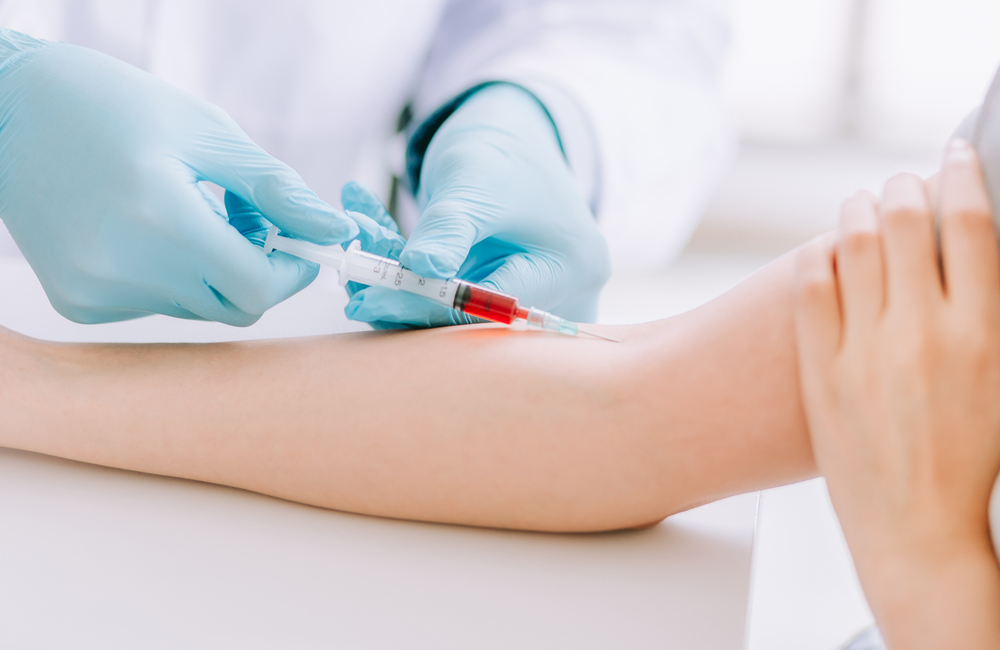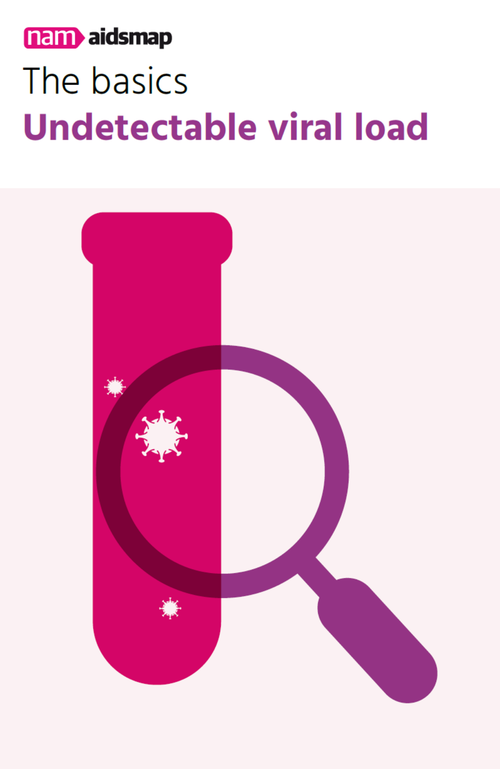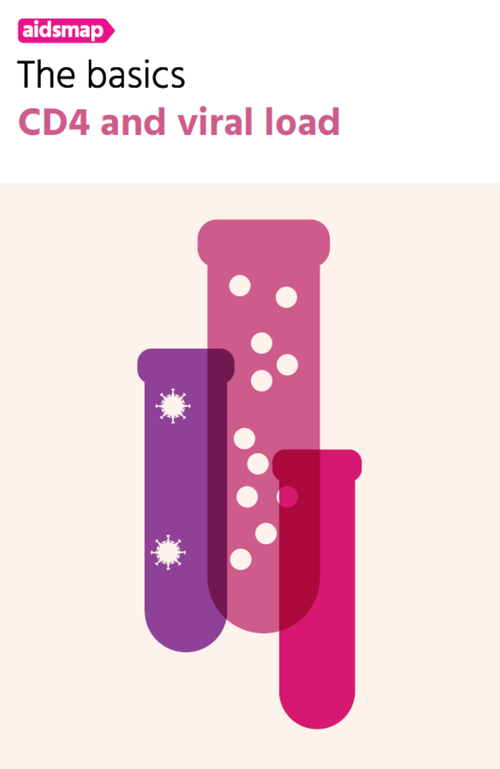
Key points
- Effective HIV treatment results in a fall in viral load.
- An undetectable viral load is the aim of HIV treatment.
- People who are taking effective HIV treatment and have an undetectable viral load do not pass on HIV.
Viral load is the term used to describe the amount of HIV in your blood. The more HIV there is in your blood (and therefore the higher your viral load), then the faster your CD4 cell count will fall, and the greater your risk of becoming ill because of HIV.
If there is so little HIV in your blood that your viral load is ‘undetectable’, then there is no risk of HIV being passed on, even if condoms aren’t used.
Viral load tests measure the amount of HIV’s genetic material in a blood sample. The results of a viral load test are described as the number of copies of HIV RNA in a millilitre of blood. But your doctor will normally just talk about your viral load as a number. For example, a viral load of 10,000 would be considered low; 100,000 would be considered high. Viral load changes can be very large, so they are sometimes quantified using the powers of ten, or ‘log scale’. A 1-log change is the same as a 10-fold change (so 5000 to 50,000 or vice versa); a 2-log change is a 100-fold change and is written as 102.
Your viral load if you are not taking HIV treatment
You should have your viral load measured when you are first diagnosed with HIV. If it is known that you have very recently become HIV positive (a period known as primary infection), you will have it measured three to six months later to determine your viral load ‘set point’ – the level of your viral load once it stabilises when the period of primary infection is over.
Your viral load will be checked at least once a year, and more often if you have any symptoms. Your viral load can provide important information about the way that HIV might affect your health if it is left untreated. Among people with the same CD4 cell count, those with a high viral load tend to lose CD4 cells and become ill faster.
Your viral load also provides information about the risk of passing HIV on during sex without a condom. The higher the viral load, the greater the chance of this happening. (There’s more on this later in this section.)
If you’re not taking HIV treatment, the level of your viral load can fluctuate between tests. Often, increases in your viral load are nothing to worry about. Even a doubling in your viral load might not be significant.
Vaccinations, such as a flu jab, and infections can cause a temporary increase in your viral load. Talk to your doctor about whether you should delay your next viral load test – sometimes it is recommended to wait at least one month after having a vaccination or getting over an infection.
Like your CD4 count, it is best to look at the trend in your viral load over time. When viral load results over several months show a continuing increase, or when the increase is greater than threefold, there may be a cause for concern.
For example, an increase from 5000 to 15,000 shouldn’t cause you to worry when you are not on treatment. A rise from 50,000 to 100,000 may not be significant, but a rise from 5000 to 25,000 is likely to be significant. This result suggests your viral load is five times the level it was at your last viral load test.
Your doctor will probably want to confirm this trend with a repeat test.
When you’re thinking about starting HIV treatment, one of the factors your doctor will discuss with you is your viral load. Your viral load can also be a factor in choosing which anti-HIV drugs you start treatment with.
You’ll have a viral load test just before you start HIV treatment.
Viral load if you are taking HIV treatment
Your viral load should start to fall once you start HIV treatment. Taking your treatment in the right way, every day, gives it the best chance of working. If you are having difficulty taking your treatment, for any reason, it is really important to talk to your doctor or another member of your healthcare team about it.
Your doctor will check your viral load within a month of starting treatment, and again three and six months after starting treatment.
Your viral load four weeks after starting HIV treatment is a good indicator of whether it will become undetectable on this combination of anti-HIV drugs.
The aim of HIV treatment is an undetectable viral load. Your viral load should have fallen to undetectable levels within three to six months of starting HIV treatment. If this doesn’t happen, your doctor will talk to you about possible reasons for this and discuss what to do next.
Once you have an undetectable viral load, you will have your viral load monitored every three to four months. If you have had an undetectable viral load for some time and are doing well on treatment, your doctor may offer you the option to have your viral load measured every six months or every year.
Undetectable viral load
All viral load tests have a cut-off point below which they cannot reliably detect HIV. This is called the limit of detection. When your viral load is below the level of the specific test that is being used, it is said to be undetectable.
The tests used most commonly in the UK may have a lower limit of detection of 20, 40 or 50 copies/ml. In some countries, the test’s lower limit of detection may be 200 copies/ml.
In the research which showed that “undetectable = untransmittable”, the threshold used was 200 copies/ml. If you have maintained a viral load below 200 copies/ml for at least six months and continue to have good adherence, there is no risk of passing on HIV to a sexual partner.
The way in which test results are reported can vary. Your test result might be reported as “<20”, “<50”, “<200”, “undetectable”, “not detected” (ND), “target not detected” (TND), “below the limit of detection” or “zero”.
But just because the level of HIV is too low to be measured doesn’t mean that HIV has disappeared completely from your body. It might still be present in the blood, but in amounts too low to be measured. Viral load tests only measure levels of HIV in the blood, which may be different to the viral load in other parts of your body, for example in your genital fluids, gut or lymph nodes.
Why it is good to have an undetectable viral load
Having an undetectable viral load is important for a number of reasons.
First of all, because your immune system is able to recover and become stronger, it means that you have a very low risk of becoming ill because of HIV. It also reduces your risk of developing some other serious illnesses as well. There is some evidence that the presence of HIV (especially a higher viral load) can increase the risk of cardiovascular disease (illnesses such as heart disease and stroke).
Secondly, having an undetectable viral load means that the risk of HIV becoming resistant to the anti-HIV drugs you are taking is very small.
Finally, having an undetectable viral load means that you will not pass HIV on during sex.
Detectable viral load if you are taking HIV treatment
If your viral load hasn’t fallen to undetectable levels within three to six months of starting HIV treatment, then your doctor will talk to you about your current treatment. They may ask some detailed questions about how and when you take your anti-HIV drugs and whether you have taken any other drugs – including prescription, over-the-counter, herbal or recreational drugs – at the same time. This is because not taking treatment regularly, or interactions with other drugs, can cause the levels of anti-HIV drugs in your body to be too low to work. You may have a blood test to look at the level of anti-HIV drugs in your blood and to see if your HIV has developed resistance to any drugs.
Then they will discuss the options with you. This may involve changing your anti-HIV drugs to find a combination that works for you.
Having a detectable viral load when you are taking HIV treatment can mean that your HIV may become resistant not only to the anti-HIV drugs you are taking, but also to other similar anti-HIV drugs as well.
If you are taking HIV treatment and have had an undetectable viral load, and then you have a test that shows a detectable viral load, you will need to have another test to confirm the result. It may just be what is called a viral load ‘blip’.
If later tests still show your viral load has become detectable again, you will probably need to change your HIV treatment. Your doctor will discuss your options with you.
Viral load blips
People with an undetectable viral load sometimes experience what are called ‘blips’ in their viral load. Their viral load increases from undetectable to a low but detectable level before becoming undetectable again on the next test.
Viral load blips do not necessarily show that your HIV treatment is no longer working.
There are a number of theories about the reasons for blips. These include variations in the laboratory processes, or having an infection like a cold or the flu.
If your viral load stays above detectable on two consecutive tests, or possibly if you have fairly frequent blips, your doctor will want to discuss possible causes and whether you need to change your treatment.
Viral load and sexual transmission of HIV
If you have a high viral load in your blood, then you might also have a high viral load in other body fluids, including your semen or vaginal fluid. In the first few weeks after contracting HIV, viral load is usually extremely high. People with high viral loads are more infectious and can pass HIV on more easily. On the other hand, if HIV in your blood is undetectable, it is likely to be undetectable in your semen, vagina fluid or rectum as well.
Having an undetectable viral load means that you will not pass on HIV during sex.
In 2011, a large scientific trial found that HIV treatment reduces the risk of passing on HIV to a regular heterosexual partner by 96%. The only reason it was not 100% is that one person in the trial did acquire HIV, but this happened just a few days before or after their partner started treatment.
The final results of the PARTNER 1 and PARTNER 2 studies were announced in 2016 and 2018, respectively. Between the two of them, they recruited 972 gay couples and 516 heterosexual couples in which one partner had HIV and the other did not. Over the course of the study, the gay couples had 77,000 acts of condomless penetrative sex and the heterosexual couples 36,000 acts. The PARTNER studies did not find a single HIV transmission from an HIV-positive partner who had an undetectable viral load (below 200 copies/ml).
In 2017, a similar study exclusively of 343 gay male couples, Opposites Attract, also found no transmissions from partners with an undetectable viral load in 17,000 acts of condomless anal sex.
A lot of people with HIV see not being infectious and the associated relief from anxiety about transmission as very important benefits of HIV treatment. You may wish to take your viral load and your likely infectiousness into consideration when thinking about safer sex.
If you want to stop using condoms, it is important to wait six months after your first undetectable viral load test, to be sure that treatment is working. It is also important to discuss this issue carefully with your partners and ensure they are also comfortable with the decision. Explaining what an undetectable viral load means may reduce HIV-negative partners’ anxiety about HIV transmission, but this information may be new to them.
While HIV treatment and an undetectable viral load will protect your partners from your HIV, they do not protect them or you from other sexually transmitted infections (STIs). Also, in some countries, condomless sex without disclosing your HIV status is a criminal offence, regardless of the likelihood of HIV transmission.
If you are using HIV treatment in order to prevent sexual transmission, it is recommended to have it checked more often (every three to four months) than might otherwise be the case. This is to check that your viral load is still undetectable.
Looking at CD4 and viral load together
If you’re not currently taking HIV treatment, looking at your viral load and CD4 cell count can help predict your risk of becoming ill because of HIV in the future. While your CD4 cell count is the main indicator your doctor will use to help monitor the health of your immune system, viral load testing can also provide important information.
Among people with the same CD4 cell counts, research has shown that those with a higher viral load tend to develop symptoms more quickly than those with a lower viral load.
In addition, among people with the same viral load, those with lower CD4 cell counts tend to become ill more quickly.


